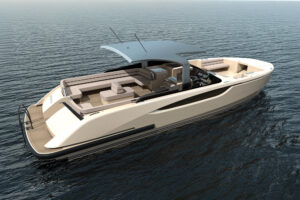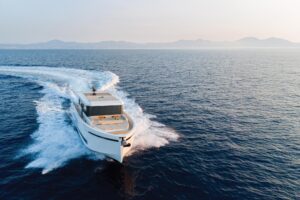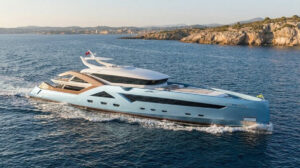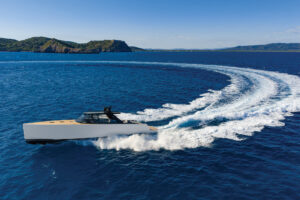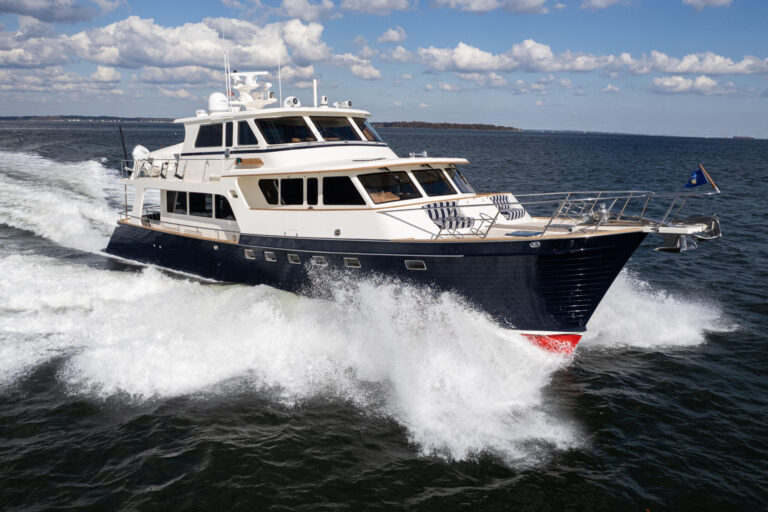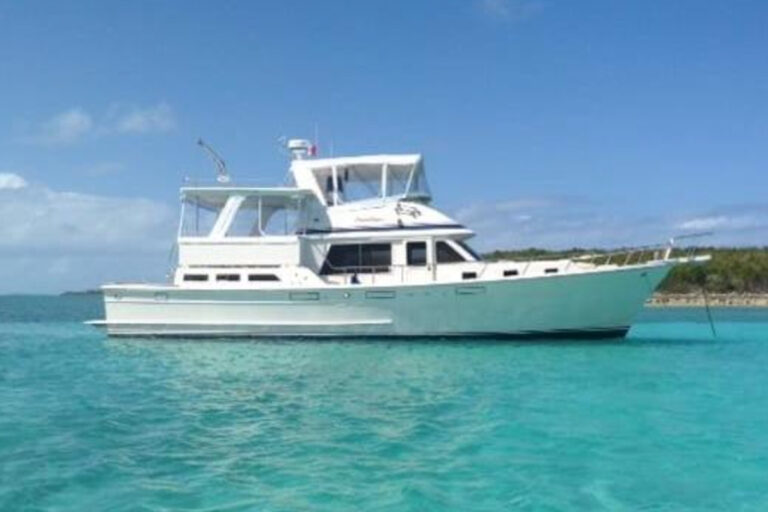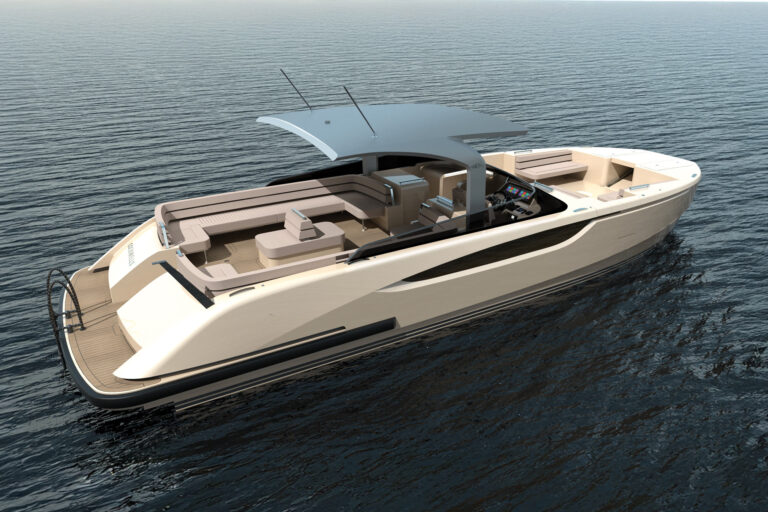I am fortunate to have cruised some interesting parts of the world, perhaps seizing the opportunities while avoiding nagging responsibilities shoreside. Still, every time I cast a rod into the surf as the rising sun splinters the horizon, I have no recollection of what earth-shattering duties might have kept me from the moment. Thanks to technology, my job is a little more secure these days and my wanderlust is slightly more at bay, but a recent weekend cruising the Chesapeake Bay aboard the new Lagoon Power 43 has again left my mind full of visions that are blissfully counterproductive.
Lagoon made its mark with spirited, roomy sailing catamarans from 38 feet to 67 feet. The 43 is the builder’s first foray into the power market, and it stands apart from the offerings of some other sailboat manufacturers that simply remove the stick and add bigger engines.
The 43’s hulls are a semi-displacement design with a deep forefoot to reduce pounding. A chine above the waterline displaces spray. After extensive trials on hull number one, Lagoon retooled the mold to increase chine on the hull’s inside and displace water hitting the platform between the hulls.
Our weekend cruise was effortless, with twin 190 hp Yanmar diesels pushing us to cruise at 15 knots and topping out at 20. We recorded only 68 decibels at the helm at cruising speed with the saloon doors closed. Lagoon placed both engines’ exhaust on the inside of the hull, which reduces noise and eliminates station wagon effect into the cockpit. Even with the master stateroom’s cockpit door open, no smoke or soot found its way inside from the clean-burning Yanmar turbo diesels. Lagoon also offers 250 hp Yanmar diesels.
The 43’s motion, or perhaps what is more accurately described as a lack of motion, takes some getting used to. My time spent in unpleasant weather aboard semi-displacement hulls has me used to shuffling in baby steps with legs spread apart and one arm stretched before me. The more stable platform offered by a catamaran offers less-abrupt motion in a seaway. I suspect the Lagoon will also have good characteristics in a following sea, since there is less surface at the transom to resist water.
Another catamaran attribute that takes some getting used to is the slapping of a large head sea under the platform. Lagoon designed a V-shape wedge to help displace water and reduce pounding. A long keel protects the props, and the 43 can actually sit on her bottom if needed. “You can set the bottom flat, theoretically beaching it,” said Bruce Wagner, Lagoon America’s director, who spent a fair amount of time on hull number one.
“I’ve provided a lot of feedback back to the factory, and we’ll make some changes,” Wagner said. “The cockpit cover, for instance, will be fiberglass. We’re going to a different floor in the cabin. The cockpit seats will have more bolster.”
The flying bridge model, which is what Wagner expects to sell the most of, will make her rounds at the fall boat shows. Well-known yachtsman and designer Ted Hood purchased the show boat, a model I prefer and am eager to see in final form.
There is plenty of on-deck stowage for toys. A compartment forward of the house is nearly 5 feet deep and can easily absorb dive tanks, a dinghy, an outboard, fenders and lines. Two additional forepeak lockers and two lockers on the afterdeck should help keep the 43 self-sufficient for weeks. Another compartment in the cockpit sole contains a liferaft locker.
I was most taken with the 43’s cockpit area. As a kid in St. Barts (long before it was discovered by the jet set), I remember having little living space in the house besides a large pine table on a porch with comfortable chairs. This is where we ate every meal, and the area was the social center for the entire home. The Lagoon 43’s cockpit is a similar space. A table sits eight for meals, and a settee wraps around the cockpit to seat 12. We started one day in the cockpit with fresh-brewed coffee, fruit and cheese. Breakfast gradually turned to lunch, which faded into cocktails and hors d’oeuvres that blended into dinner. I was so comfortable, it took me 24 hours to leave the yacht and explore the charming village of St. Michaels, Maryland.
The cockpit flows nicely into the saloon through a large sliding door. It’s difficult to determine where one space ends and the other begins. Cool breezes fill the interior, and sunlight opens the space. The saloon remains cool thanks to the cabin top’s overhang over the windows. Working with a laptop at the L-shape settee, I didn’t feel like I was missing the outside action. Vertical windows provided a superior line of sight, with the only blind spot behind the galley.
Hull number one has a lower helm option, which should be standard. Not only are lower helms useful when the weather turns foul, they are a great air-conditioned place to drive when it is blazing hot outside. Lagoon should consider installing more than one wiper to give the helmsman a better view of the horizon.
The galley, however, needs no further refinement. It includes a front-loading 12-volt refrigerator and a top-load unit, which also provides good counter space. Again, stowage is everywhere, including a three-quarters height pantry, a bottle locker, a pot and pan drawer, and a dish locker. A four-burner range is under an opening hatch for added ventilation.
One of the 43’s most impressive features is her after cabin, which spans both hulls. The berth is in the middle, where standing headroom is not required. Ports surround the area, and an opening hatch is over the foot of the berth. There are his-and-her hanging lockers as well as a third locker, which will be great for linens. The head is split, with a sink and MSD to port, as well as a shower, if needed. To starboard is a commodious shower stall with sink. The head is at the foot of the stairs to the stateroom’s private entrance, which means a shower after a day at the beach won’t require trenching water through the interior.
Two identical staterooms are forward, both with wet heads. I took the starboard forward stateroom, which was so comfortable I had to rip myself out of bed to take a few pictures as the sun came up. Two opening ports and an overhead hatch funneled in fresh breezes, and the clearance over the berth provided an open feeling not found in many forepeak staterooms. I would install a few deep shelves to compensate for the one, albeit large, drawer.
Additional stowage is in the passageway, which also houses the AC/DC panel. The panel needs to be protected by a door or recessed deeper so people passing by won’t hit the breakers.
Totally equipped, the Lagoon is about $430,000.
Lagoon America, (410) 280-2368; www.cata-lagoon.com.

